| Article ID | Journal | Published Year | Pages | File Type |
|---|---|---|---|---|
| 1952229 | Biochimie | 2010 | 6 Pages |
Leukotrienes are a family of proinflammatory lipid mediators of the innate immune response and are important signaling molecules in inflammatory and allergic conditions. The leukotrienes are formed from arachidonic acid, which is released from membranes by cPLA2, and further converted by 5-lipoxygenase to form the labile epoxide leukotriene (LT) A4. This intermediate is converted by either of the two enzymes, LTA4 hydrolase or LTC4 synthase, to form LTB4 or LTC4, respectively. In order for 5-lipoxygenase to work efficiently in cells, five-lipoxygenase-activating protein needs to be present. LTB4 is one of the most powerful chemotactic agents whereas LTC4 induces smooth muscle contractions, for example in the airways causing bronchoconstriction in asthmatic patients. The leukotrienes and the five enzymes/proteins involved in their formation have been subject to intense studies including drug design programs. Compounds blocking the formation or action of leukotrienes are potentially beneficial in treatment of several acute and chronic inflammatory diseases of the cardiovascular and respiratory systems. In order to succeed with drug development studies, knowledge of the molecular characteristics of the targets is indispensable. This chapter reviews the biochemistry, catalytic, and structural properties of the enzymes in the leukotriene cascade.
